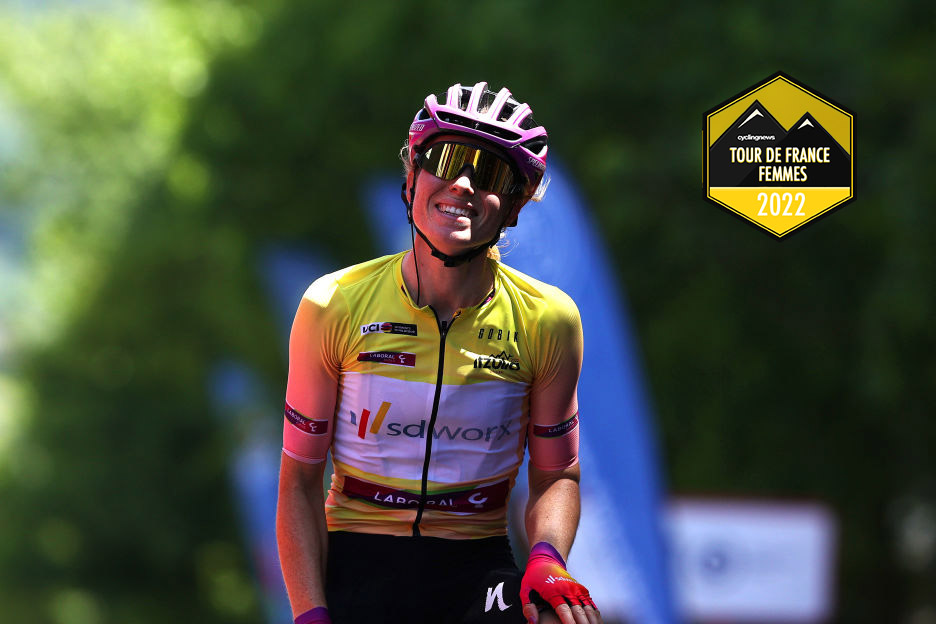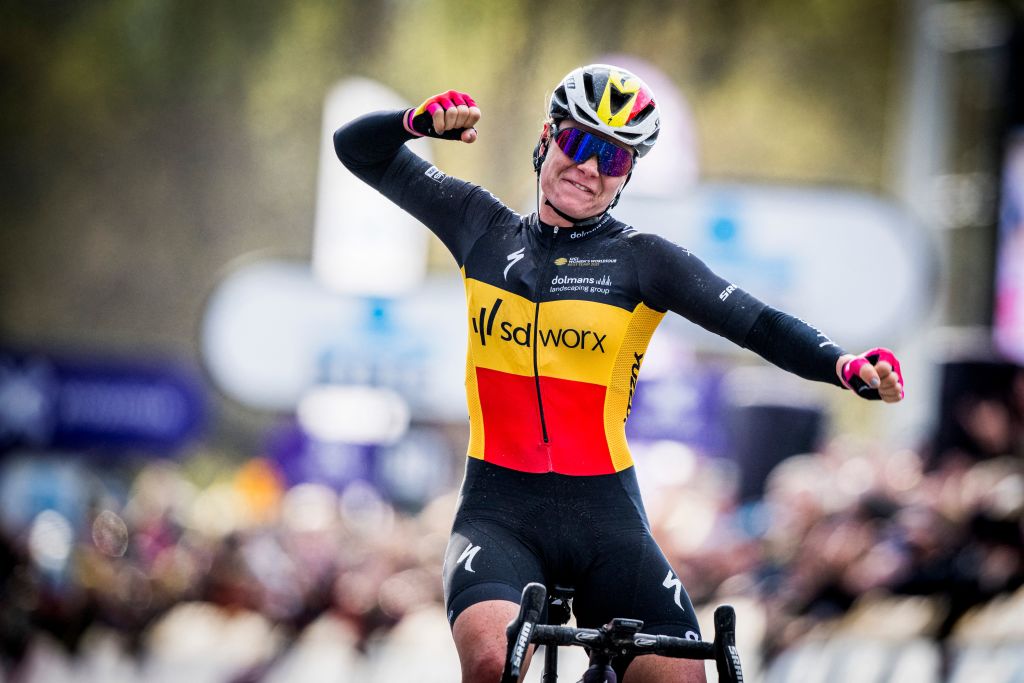To race or to train? Vollering and Kopecky testing different approaches to Tour de France Femmes
SD Worx duo will be targeting stages and the overall in France this July - but their journeys have been very different

In the first season of the Tour de France Femmes, it is already one of the most anticipated races on the calendar, and yet there is no blueprint of how to prepare for such a big goal. With only two Grand Tours in the WorldTour, and few preparatory stage races to use as build up, there’s not yet a natural path towards the demanding month of July. As a result, riders and teams have had to carefully devise their own preparation plans and the list of variables has grown long.
Every team and every rider have taken different approaches, but for SD Worx - who want to win not only stages but the overall too - it has been even more important to try and get their plans just right. Demi Vollering and Lotte Kopecky have had markedly different run-ins to the Tour de France Femmes, and they explained why.
Giro or no Giro?
Though the Giro offered a good opportunity to race and tackle some big climbing days ahead of the Tour de France Femmes, its proximity to its French equivalent meant riders had to think carefully about whether to race it or not. There have been just 13 days between the end of the Giro and the start of the Tour - fewer if you consider the travel and media commitments round each race - making recovery between the races a potential challenge. With few other months on the calendar featuring such a quantity of race days, riders had little to go on in making their decisions about the two races.
Despite the unknowns and question marks, many riders decided to do both, including Giro winner Annemiek van Vleuten (Movistar) and GC hopefuls Juliette Labous (Team DSM) and Cecilie Uttrup Ludwig (FDJ-SUEZ-Futuroscope). But for Demi Vollering, who finished 3rd overall in Italy last year, the safe option seemed to be to skip the Giro.
“I did the Giro only two times in my life, and both times I was not so good coming out of the Giro,” Vollering said. “So that was the main reason why I made the decision to not do the Giro because I’m afraid to come out of it again not super good - that’s something I don’t want to risk.”
What works for Vollering, though, is not what works for everyone, and not even what works for the SD Worx outfit in general. It seems that the type of rider and the type of stages they are targeting has had an effect on whether or not riders choose to ride the Giro when they’re also aiming at the Tour. Marianne Vos (Jumbo-Visma) took a mixed approach, racing the first half of the Giro but going home early in order to focus on the Tour.

Vollering’s teammate Lotte Kopecky - and many sprinter and puncheur-type riders - raced the entire Giro and is now set for the Tour, but Vollering suggests that while that may work for riders targeting the first half of the Tour, keeping form all the way to the end is a bigger challenge.
Get The Leadout Newsletter
The latest race content, interviews, features, reviews and expert buying guides, direct to your inbox!
“I want to be good in the last two stages at the end of the Tour, so I think it will be hard to do a good Giro and then be good again at the end of the Tour,” Vollering explained. “For example, for Lotte, she does the Giro, but for her the main goals are at the beginning of the Tour de France, so then it’s a bit easier. In the end it’s still eight days that you need to survive again.”
For all that Vollering had concerns about the effect of the Giro on her racing legs, Kopecky went into the race seeing it as a chance to fine-tune her form ahead of the Tour. In many ways, Kopecky had more modest goals at the Giro: more an all-rounder than a pure sprinter, there were fewer stages that suited her, and she could comfortably fit more into a team role than take on the mantle of leader. In the end, her lowkey results in Italy reflected this - second on stage 6 was her best finish - but that’s not to say the race didn’t have the desired impact on her preparation.
“I think this combination of the Giro and the Tour can go both ways. At this moment, I’m still able to improve my form, and I think I can really use the Giro for it,” Kopecky said before the race. “And then there’s two weeks in between, so I think that’s just enough time to recover and have this super compensation in the Tour de France. But I think this combination is really doable, and there are more riders who are doing this.”
Race hard, train harder
Two of the biggest favourites for the Tour de France Femmes, Annemiek van Vleuten and Demi Vollering, share one big similarity in their preparation for important goals: they often prefer to train hard in the run-up, rather than try to find their form in races. Though it’s to be celebrated that the Giro and the Tour feature high mountains and long climbs, it’s also true that there are few opportunities earlier in the season to race on similar terrains. Rather than spend June racing the somewhat hilly Women’s Tour, GC riders swap races for training, hunting out roads and challenges to replicate the decisive days ahead.
Whilst Van Vleuten rode - and won - the Giro Donne last month, Demi Vollering has dedicated over two months almost exclusively for training, and has in fact been shaping her riding around the Tour de France Femmes since the route was revealed back in October. Living in Switzerland near the Vosges mountains, Vollering is fortunate that many of her local routes take in parts of the Tour’s key climbing stages, but she has also spent significant periods at altitude and, most recently, on a climbing camp in the Alps. With few opportunities to tackle such climbs in races, Vollering trusts her training to be the best preparation.
“I think I can really do hard training by myself, so I do a lot of hard training work,” she said. “Of course my goal is being good at the end of the Tour de France Femmes, so also I have a few stages in front already where I can get a little bit in the racing mood again if that’s needed. But I think this is the best way for me to be there on my best form. Well, I hope that’s the best way, we will find out when I’m there on the start line.”
Even though Kopecky raced the Giro, the Belgian has also not racked up many race days since the end of May, with pre-Tour training clearly taking up much of riders’ time and attention. After racing the RideLondon Classique in May, Kopecky also took part in an altitude camp, and only raced Nationals in the month of June. Perhaps more clear cut than the ‘Giro or Tour’ conundrum is the fact that, for many riders, the races building into July are not necessarily how the top competitors want to prepare.
Unknown competition
One of the side effects of doing such little racing in the run-up to the Tour is having few opportunities to test yourself against your rivals. For Vollering, this has been compounded by the fact that her main rival Van Vleuten has been out with a wrist injury since the start of May, missing the Spanish stage races that Vollering did race. The one race Vollering did start in June - the Dutch national championships - Van Vleuten decided to skip.
When the Tour de France Femmes starts on Sunday, the two Dutch women won’t have raced each other since Liege-Bastogne-Liege in April. For some riders, this might be a concern, but for Vollering, the fitness of her main rival is not occupying much space in her mind.
“I’m not really busy with how she is,” Vollering said. “I’m more focused on how I will be there. That’s the only thing I can do, to be there on my best form and hope that that is enough to beat her. There’s not much you can do about that, about how she is, so I’m not focusing on that but more on myself. I want to be there in my best form and I will use the upcoming training periods to be at my best there. We will see how it goes.”
With the Giro complete but still over a week until the end of the Tour, the successes or failures of Vollering and Kopecky’s different methods remain to be seen. The first Tour de France Femmes sits in a difficult space of being an enormous goal, but also a big unknown, and it’s almost impossible to predict what will work. But with the examples of Wiebes vs Balsamo, Kopecky vs Vos and Van Vleuten vs Vollering all ready to demonstrate how different preparation pays off, the winners at this Tour may come away with not only victory, but the knowledge of how to get it right in years to come.
Matilda is an NCTJ-qualified journalist based in the UK who joined Cyclingnews in March 2025. Prior to that, she worked as the Racing News Editor at GCN, and extensively as a freelancer contributing to Cyclingnews, Cycling Weekly, Velo, Rouleur, Escape Collective, Red Bull and more. She has reported from many of the biggest events on the calendar, including the Giro d'Italia, Tour de France Femmes, Tour of Flanders and Paris-Roubaix. She has particular experience and expertise in women's cycling, and women's sport in general. She is a graduate of modern languages and sports journalism.